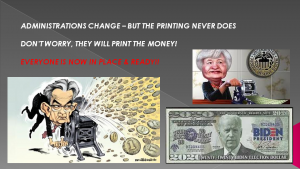IN-DEPTH: TRANSCRIPTION - UnderTheLens – 04-27-22 - MAY – The Coming Dependency Stranglehold
SLIDE DECK
TRANSCRIPTION
SLIDE 2
Thank you for joining me. I'm Gord Long.
A REMINDER BEFORE WE BEGIN: DO NO NOT TRADE FROM ANY OF THESE SLIDES - they are COMMENTARY for educational and discussions purposes ONLY.
Always consult a professional financial advisor before making any investment decisions.
COVER
I want to expand on some of my recent newsletters, as well as last month's UnderTheLens video, about the increasing strategic value of commodities.
SLIDE 4 – PUTIN’S CHESSBOARD
In last month’s UnderTheLens video I began to layout the Thesis that there is strategic shift occurring in the importance of commodities further advanced by the US and other developed nations placing sanctions on Russian economic activity.
The sanctions were intended to both stop Russian military aggression against Ukraine and additionally punish Russia. As we previously wrote (here & here), they have resulted in what many deem as Unintended Consequences. However, it is becoming much more evident with time that Russia was well prepared for these expected actions by the US and in many ways has turned them against the western economies.
I cite the Russian ruble now being higher than when sanctions were applied, as Russia will now only accept their banned energy sales in Rubles. Obviously there are buyers!
SLIDE 5 – MACRO & INVESTMENT THEMES FOR 2022
Current developments are overlapping with a number of our expected Macro Themes for 2022. In many ways they are natural and expected result of the reasons we gave at the beginning of the year in highlighting these 2022 Themes.
SLIDE 6 – AGENDA
What we will focus on in this video is how this has come to happen, both through the circumstances of unfolding “Stages” as a result of the fallout of a Post-Covid world, but additionally through some possibly cleverly hidden Geo-Political Strategy at work.
As such I hope to cover the items shown here.
SLIDE 7 - DEPENDENCY – THE ACHILLES HEEL OF INDUSTRIALIZATION
As many nations shifted from Agricultural Economies to Industrial Economies at the turn of the last century, readily available and abundant commodities were turned into consumer goods. Mercantilism assisted in lessening the value of commodities.
Commodities couldn’t command the prices that value added production processes in the developed imperial nations could.
SLIDE 8
Over the 100 years of advancing technology and the goods and services they have spawned, the value of commodities has only weakened further.
Today, to say something is a “commodity” is to imply it is cheap; supplies little value-add and is readily available!
Globalization and Global Supply Chains only further reinforced this belief as increasingly, marginally profitable commodity players were forced out of business or consolidated by major global conglomerates. Global conglomerates have come to exercise major power over many of the Emerging Market nation’s economies solely dependent on their commodity exports.
SLIDE 9 - COVID REALITY SHOCK
The Supply Shock the world witnessed as we slowly emerged from Covid lockdowns was startling to many. Suddenly we experienced shortages or unavailability of products, often as a result of a single component. We were faced with the reality of Supply Chains and their inherent design of foreign dependency on the basic needs of a high value adds economy.
Prices quickly shot up creating inflation shocks as basic Supply/Demand pricing mechanics took over. The Demand-Supply Curve was alive and well and not relegated to the dust bin of history.
Hidden beneath all the headlines of the goods we understood was also the fact that shortages were highly centered in supplying basic commodities from oil and gas, to cocoa and coffee, to rare minerals and mined metals, along with commodities used in the more visible consumer demand goods.
SLIDE 10
Fossil Fuels have been the target of carbon reduction and the shift to Green Technology.
Few of the aggressive Green activists have any understanding of how many products are totally dependent on the carbon based fossil fuel production process.
This chart illustrates just 72 critical industrial sectors. Automotive is only one sector but is the Holy Grail for elimination by the Green movement with no consideration for the full fall-out. Is it naiveté, carelessness or an attempt to achieve more than a green technology revolution?
Don’t for one moment think I am not myself Pro-Green. However, the food products I buy come in plastic containers, cosmetics my wife uses depends on them, fertilizers I plant my garden with are based on them. And the list goes on. We have been and presently are slashing investment in anything “Fossil” and making corporate ESG goals anti -“Fossil”!
To me our uninformed, poll driven politicians are like turning kids loose with matches to play with in a dry forest.
SLIDE 11
As I pointed out in “Putin’s Chessboard” we have forgotten that an Industrial nation is built on cheap energy to drive productivity and readily available inexpensive materials to feed production. Without both, a countries competitive advantage and standard of living quickly vanishes.
SLIDE 12
It is worth spending some time talking about the commodity sector as few really appreciate it other than it is something that is traded in the futures pits.
That in itself is problematic since commodities are therefore valued as nothing more than speculative paper financial instruments, manipulated by traders and speculators and prone to wild and erratic price swings. Many economies have to live within these seemingly irrational realities.
SLIDE 13
Approximately 53 countries or nearly 30% of all countries are dependent on various types of fuel based commodities as their number one export supporting their economy. 50 countries or nearly 27% are dependent on Metal, Mineral or Organic as their top export. 35 countries or approximately 19% are dependent on Food or Produce commodities.
We therefore have around 138 countries, or ¾’s of all countries on the planet having economic dependency on the export of commodities. In many ways they are still the feudal mercantile slaves of old.
These are countries that have been relegated to the bottom of the perceived value chain with:
- Little economic leverage,
- Dependent on the value of the US dollar for the pricing of their product at the cost of their own currency,
- Little political power and
- Often having low standards of living as a result.
SLIDE 14
As I laid out in the “Putin’s Chessboard” video last month, many of these countries have now banded together under various organizational structures lead by China and Russia.
Together they have power.
Power, that I will show you will soon result in increased Pricing Power!
I won’t go into the Geo-Political Strategy and consequences here, but rather refer you to the “Putin’s Chessboard” video and a number of my supporting newsletters which expand on the video.
SLIDE 15
The returns on commodities over the last two years are reflecting this increasing pricing power. I believe this is only the beginning as we enter the Commodity Super Cycle which I laid out a couple years ago as a major investment theme for this decade.
SLIDE 16
This chart puts into perspective the importance of oil relative to major metal commodities. As you saw on the prior slide approximately 53 countries in the world have fuel as their number one export. This chart is showing only oil. There are other fuels like LNG which shows you how important energy products are. As we have seen with recent price surges at the US pump, and major shortages in Europe and the UK, energy has become a “prime time” topic over the last 12 months.
Also missing from this chart is the entire global Food and Produce sector, which we will get to.
SLIDE 17
Though by size rare earth minerals didn’t make the last chart they have become strategically important in the high technology world we now live in. Increasingly, small deposits and few mines can dominate supply and availability of sophisticated products.
Even larger and once available minerals such as Lithium, Cobalt and Nickel have suddenly become problematic as battery powered EV transportation becomes mainstream in a global economy of 8.3 billion people!
SLIDE 18
As significant as mounting supply problems are in the area of energy and minerals, my bigger concern in the longer term is food and produce!
- China has been stockpiling commodities since 2019 and according to estimates by the US Department of Agriculture currently holds:
- 80% of global copper inventories,
- 70% of corn,
- 51% of wheat,
- 46% of soybeans,
- 70% of crude oil, and
- Over 20% of global aluminum inventories.
- We see Russia retaliating against economic sanctions by restricting their commodity exports to "friendly" countries only. Dmitry Medvedev, a senior Russian security official who previously served as the nation’s president, has threatened that Russia may soon cut off the West from food exports and limit food exports to only nations it considers to be “friendly nations”, According to Sanford Bernstein analyzes, the implications of the Russian/Ukraine conflict on global food involves some of the following:
- Ukraine represents ~10% of global wheat exports in 2021, with Russia at a further 17 -18%.
- Ukraine and Russia combined supplied over 60% of global sunflower oil exports last year.
- The conflict is causing disruption in this spring’s crop planting. Fuel, fertilizer and labor shortages could lead to a 30% reduction in cultivated areas for spring crops including wheat and soybeans.
- To compound matters further, Russia is a leading global exporter of fertilizers. The sanctions imposed on Russia plus protectionist moves to limit exports by Russia is driving unprecedented levels of agriculture commodity inflation, which will likely persist for some time.
- In terms of oils and grains, Mills and Kellogg are most exposed. Tyson has exposure to corn and soybean meal within its chicken business.
SLIDE 19
- German Retailers Have Now Been Forced to Increase Food Prices By anywhere from 20-50% (between 20 and 50 percent)
- Germany has taken one step further toward a return of the dreaded Weimar hyperinflation, when according to the German Retail Association (HDE), consumers should prepare for another wave of price hikes for everyday goods and groceries with Reuters reporting that prices at German retail chains will explode between 20 and 50%
- Germany recently reported the highest inflation in generations with February headline CPI soaring at a 7.6% annual pace and blowing away all expectations.
- This is giving Germans a distinctly unpleasant deja vu feeling even before the Russian invasion of Ukraine broke what few supply chains remained and sent prices even higher into the stratosphere
- Ukraine Fall-Out
- France’s Foreign Affairs Minister Jean-Yves Le Drian said the EU must come to grips with the prospect that the war in Ukraine could prompt an “extremely serious” global food crisis.
- Even the somewhat tone deaf Biden administration is now worried Russia’s invasion of Ukraine will cause famine in parts of the world. White House Council of Economic Advisers Chair Cecilia Rouse highlighted this on CNBC recently.
SLIDE 20
- Wheat Exports have become a serious global problem. For the non cooks reading, Flour is a core ingredient of any kitchen
- In a typical year, Russia and Ukraine collectively account for approximately 30 percent of all global wheat exports.
- Half of Africa’s wheat imports usually come from either Russia or Ukraine.
- Other nations rely on wheat exports from Russia and Ukraine even more than Africa does…
- Armenia, Mongolia, Kazakhstan and Eritrea have imported virtually all of their wheat from Russia and Ukraine and must find new sources. But they are competing against much larger buyers, including Turkey, Egypt, Bangladesh and Iran, which have obtained more than 60 percent of their wheat from the two warring countries.
SLIDE 21
- Fertilizer Shortages have now become a serious problem with farmers.
- Since this time last year, some fertilizer prices have gone up by as much as 300 percent.
- Many farmers in Africa will not be able to afford fertilizer at all this year, and it is being projected that this will reduce agricultural production by an amount capable of feeding“100 million people”…
- With prices tripling over the past 18 months, many farmers are considering whether to forgo purchases of fertilizers this year. That leaves a market long touted for its growth potential set to shrink by almost a third, according to Sebastian Nduva, program manager at researcher group AfricaFertilizer.Org.
- That could potentially curb cereals output by 30 million tons, enough to feed 100 million people, he said.
- Russia is normally one of the biggest global exporters of fertilizer…
- Russia is a key global player in natural gas, a major input to fertilizer production. Higher gas prices, and supply cuts, will further drive fertilizer prices higher. Russia is one of the biggest exporters of the three major groups of fertilizers (nitrogen, phosphorus and potassium). Physical supply cuts could further inflate fertilizer prices.
SLIDE 22
I could go expand on the endless shortages we are seeing because of the North American Bird Flu Pandemic, the Chinese Swine Flu Pandemic or shortage due to increasing crop failures as a result of “100 year” Weather related events, but I won’t. I talked extensively about weather issues in the March UnderTheLens issues entitled “Greenflation”.
The head of the UN World Food program says that what the planet is now facing is unlike anything that we have seen since World War II…
“Ukraine has only compounded a catastrophe on top of a catastrophe,” said David M. Beasley, the executive director of the World Food Program, the United Nations agency that feeds 125 million people a day. “There is no precedent even close to this since World War II.”
The head of BlackRock is warning that this will be the very first time this generation “is going to go into a store and not be able to get what they want”…
SLIDE 23
What we are entering is a potential Perfect Storm coupled with a possible Geo-Political Chessboard at work.
The problems can be seen a little clearer if we examine the stages we have been going through which has significantly hidden much of the long term reality of what is occurring …. and where it is likely to lead!
SLIDE 24
Stage I, I would label as Pre-Covid. Here we saw two primary drivers underway.
- A Global priority given to combating Climate Change through Green Energy initiatives and government directives in the form of policy, spending and regulations. Nowhere was this more evident than in Europe where it resulted in the elimination of Nuclear Energy throughout countries like Germany, a widespread shift away from fossil fuel and coal generated electricity to Gas, Solar and Wind.
- Investment in fossil fuel exploration and production was intentionally hindered through regulations, carbon taxing and public policy to force the shift and cost effectiveness of Green technologies.
SLIDE 25
Stage II, I would label as Covid Lockdowns. Here we also two new drivers of economic conditions.
- Everyone is well aware of the Supply Chain shock that Covid lockdowns precipitated. Workers around the world were unable to go to work; companies were shutdown or attempted to have employees work from home where possible. The world had not seen a Supply Shock like this on such a massive world-wide basis. With the world operating on a JIT (Just-in-Time), Kanban or Pull System where products arrive exactly when needed and not inventoried, this meant even areas less impacted by Covid were impacted by their suppliers. The pipeline was quickly bled dry. Appreciate that many industrial and commodity processes are not easily started up once stopped. They are not like lights that go one once the switch is flipped. There are delays, complications and costs that are incurred. Additionally, critically skilled employees may not longer be available or have found other work out of necessity.
- During Covid the world also experienced unprecedented weather related natural disasters that impacted Food and Produce commodity suppliers. Again I talked about this in the march UnderTheLens issues entitled “Greenflation” and how an Inflation shock was generated from Wheat and Corn to Brazilian Coffee and Cocoa to Wines an even Taiwan semiconductors dependent on water supply.
It is here that the confusion begins, because it is perceived that everything should get back to normal once lockdowns have ended. The overlapping consequences of these 4 disruptions are not fully appreciated.
But wait it gets worse!
SLIDE 26
Stage III, I would label as Post Covid Lockdowns . Here we have once again two additional drivers of conditions within the commodity sector.
- The economic sanctions imposed by the US and other western developed economies abruptly halted trade with Russia with the exception to certain dependent EU countries. Russia’s major exports are energy at 54% of total exports. Metals and Minerals at approximately 12%, Food at just over 7%, Precious metals, stones and raw materials like wood at 10%. The remaining 17% consisting of chemicals, fur and other raw materials with less than 7% of that being any basic manufactured products or military equipment. This is was obviously a shock to importers of these items world-wide as one of the world’s largest suppliers was effectively taken offline.
- The second issue was the fallout from this shock. Importers immediately reacted about concerns regarding alternative allocations and overall scarcity. As expected this triggered hoarding further aggravating the problem even worse.
SLIDE 27
As if these six factors weren’t enough the complications of overall Geo-Political turmoil associated with Ukraine further compounded the problems. Many suppliers trying to recover from the Covid lockdowns and ramp up production were again faced with transportation bottlenecks and costs, continued shortages and trade impediments indirectly the result of sanctions and rising production costs.
We have a perfect storm which has prompted Stage IV which we are currently in. It isn’t just shortages and scarcity that we face, but now we are seeing allocations, bans and predatory actions being taken across the commodity complex.
SLIDE 28
We can expect this to get much worse as the China / Russia lead commodity consortium of countries shown earlier begins to exert their new found power to leverage achieving other political and social needs. Stage V will see countries using their leverage to gain competitive advantage.
Rising commodity prices will finally give many players the wealth to further develop this competitive advantage.
China and Russia are already doing this as they force countries to now use the Yuan and Ruble for trade with them. The collapse of the Petrodollar has already seen Saudi Arabia start shipping oil to China and accepting Chinese currency. Countries like Israel last week reduced its FX reserves of US dollars by close to 10% to reflect shifting needs.
Many countries have stopped buying US Treasuries to hold their US dollar FX reserves in. They have less need. In turn US Treasury yields have spiked dramatically as bond prices have fallen based on reduced demand coupled with selling of existing holdings.
SLIDE 29
The ramifications of these drivers are only beginning to unfold and are going to be bigger the most yet appreciate.
SLIDE 30
The fallout is going to both a result of these drivers but also further drive a greater impact.
As we laid out in my recent Macro Analytics video with Charles Hugh Smith the most significant changes are going to be those shown here. I refer you to our 37 Minute video for the details but it involves the beginning of a global rebalancing of standards of living, De-Growth, Re-Shoring, De-Financialization and De-Globalization.
SLIDE 31
This not to say they are going away, but only they are DE-coupling as core expectations in a new world order.
- A Geo-Political world shifting from a Uni-Polar world to a Multi-Polar world.
- A Global reset and rebalancing of consumption and standards of living between western economies and emerging economies.
- And unfortunately, the likely outcome of global mega corporations emerging as Crony Capitalists become even more powerful!
SLIDE 32
As I always remind you in these videos, remember politicians and Central Banks will print the money to solve any and all problems, until such time as no one will take the money or it is of no value.
That day is still in the future so take advantage of the opportunities as they currently exist.
Investing is always easier when you know with relative certainty how the powers to be will react. Your chances of success go up dramatically.
The powers to be are now effectively trapped by policies of fiat currencies, unsound money, political polarization and global policy paralysis.
SLIDE 33
As I always remind you in these videos, remember politicians and Central Banks will print the money to solve any and all problems, until such time as no one will take the money or it is of no value.
That day is still in the future so take advantage of the opportunities as they currently exist.
Investing is always easier when you know with relative certainty how the powers to be will react. Your chances of success go up dramatically.
The powers to be are now effectively trapped by policies of fiat currencies, unsound money, political polarization and global policy paralysis.
SLIDE 34
I would like take a moment as a reminder
DO NO NOT TRADE FROM ANY OF THESE SLIDES - they are for educational and discussions purposes ONLY.
As negative as these comments often are, there has seldom been a better time for investing. However, it requires careful analysis and not following what have traditionally been the true and tried approaches.
Do your reading and make sure you have a knowledgeable and well informed financial advisor.
So until we talk again, may 2021 turn out to be an outstanding investment year for you and your family.
Thank you for listening






